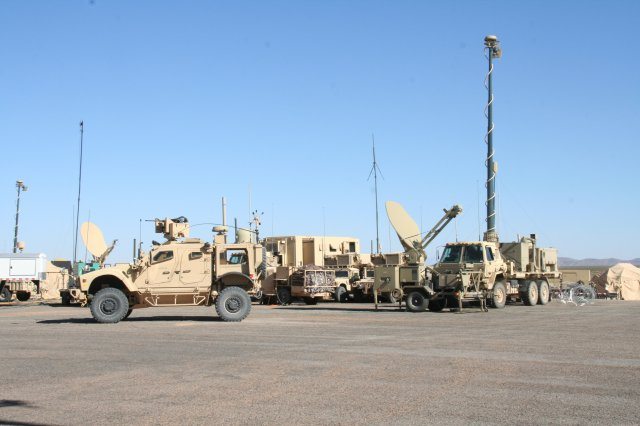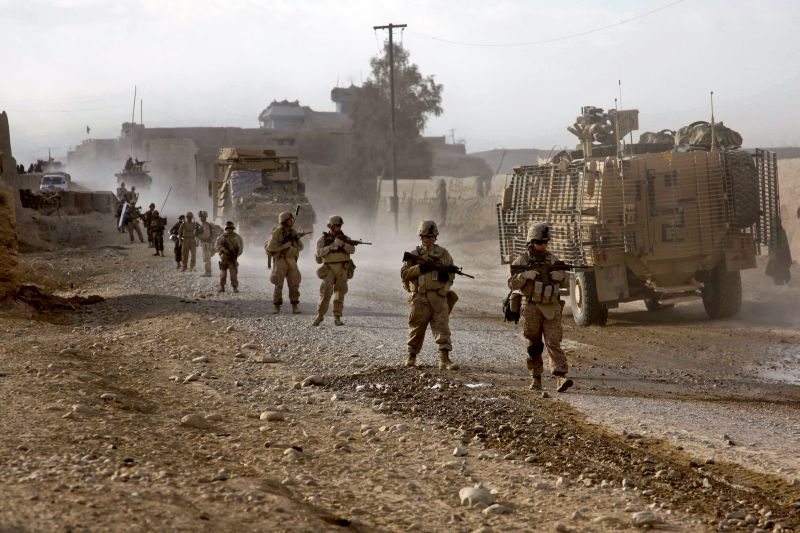Four hours into an early morning desert operation during the Army’s latest Network Integration Evaluation, Col. Thomas Dorame, 2nd Brigade, 1st Armored Division commander, was following his units in his Warfighter Information Network-Tactical Increment 2-equipped vehicle.
WIN-T Increment 2, the Army’s tactical communications network backbone, enabled him to obtain the situational awareness needed to command his forces and to even conduct a staff meeting with his troops, all from the front seat of his vehicle.
“I could make decisions on the move and rapidly provide priorities and focus back to the tactical operations center based on what I was seeing on the battlefield,” Dorame said of his WIN-T Increment 2 technologies. “I could continue the operation without having to deliberately stop. It extends your capability; it extends your range and allows us [as a force] to move more rapidly.”
During Network Integration Evaluation, or NIE, 13.1, WIN-T Increment 2 provided Soldiers down to the company level the on-the-move communications and situational awareness needed to conduct real-world battlefield operations. NIE 13.1, which concluded in November, was the fourth evaluation of its kind and was conducted at Fort Bliss, Texas, and White Sands Missile Range, N.M., utilizing 3,800 Soldiers of 2/1 AD, who executed their missions in realistic operational environments. NIE 13.2 is scheduled for May of 2013.
The NIEs aim to rapidly mature and integrate the Army’s tactical communications network, and accelerate and improve the way network technologies are delivered to Soldiers. The WIN-T Increment 2 Initial Operational Test and Evaluation was held in conjunction with NIE 12.2 last spring and the Army took advantage of NIE 13.1 to implement improvements and reduce risk prior to the WIN-T Increment 2 Follow-on Operational Test and Evaluation scheduled to be held during NIE 13.2.
Through focused follow-on tests and leveraging the NIE environment, the Army and Project Manager WIN-T plan to continue to make improvements to the tactical network and provide increased capability to the Soldier.
WIN-T Increment 1, formerly known as the “Joint Network Node – Network,” began fielding in 2004 and provides Soldiers with high-speed, high-capacity voice, data and video communications down to battalion level units, at-the-quick-halt. WIN-T Increment 2 provides Soldiers with a single, integrated and on-the-move network down to the company level. It further increases capability by introducing self-forming, self-healing networking radios and enhancing Network Operations, a suite of integrated monitoring tools used by communications officers to command and control the network.
“WIN-T Increment 2 is tremendously powerful, because you can transfer not just voice communications, but (also) data over extended distances,” Dorame said.
From his point of presence, or PoP, vehicle, Dorame was able to download and review his staff estimates, the data slides used inside the tactical operations center, known as a TOC, to manage overall operations. He was then able to make a voice phone call and tie into a conference call at the brigade TOC. His operations officer, miles away in a different part of the desert in his own WIN-T Increment 2-equipped vehicle, was also able to tie into that call. In roughly 10 minutes time, Dorame conducted the conference call with his staff and had them rapidly update him on what he needed to know about what was happening on the battlefield.
Unlike battles of the past, he said, he never had to leave his vehicle or battlefield position to go to a fixed structure to conduct these critical tasks. He could remain at the decisive point in the fight.
“The ability to do all that was tremendous,” Dorame said.
The PoP vehicle that Dorame had been driving in is a WIN-T Increment 2 configuration item to be installed on select platforms at division, brigade and battalion echelons. It enables mobile mission command by providing secret level on-the-move network connectivity, both line-of-sight (terrestrial) and beyond-line-of-sight (satellite).
Among the on-the-move mission command applications leveraged by the WIN-T Increment 2 PoP during NIE 13.1 were Tactical Ground Reporting, a multimedia, patrol-level reporting system; Command Post of the Future, which provides a collaborative common operating picture; and Joint Capabilities Release, the second generation of Force XXI Battle Command Brigade and Below, which tracks friendly and enemy forces on a geospatial imagery map. Soldiers were also able to take advantage of enterprise services accessible via the network and chat from their WIN-T Increment 2 equipped vehicles.
WIN-T Increment 2 is being fielded as part of Capability Set 13, which began fielding in October 2012 with two brigade combat teams from the 10th Mountain Division. CS 13 is the first fully-integrated package of radios, satellite systems, software applications, smartphone-like devices and other network components that provide connectivity from the stationary command post to the commander on-the-move to the dismounted Soldier. WIN-T Increment 2 is the tactical communications network backbone that binds the capability set together.
The Army leveraged NIE 13.1 to continue with follow-on CS 14 development to add additional capability to the force.
“The [WIN-T Increment 2] network gives us tremendous capabilities, not just stationary, but on the move with our on-the-move platforms,” said Maj. Ralf Radka, Dorame’s executive officer. “A commander can go in and through his vehicle he can access many of the same systems that we access in our TOC. So he can review it where he is, and working with his other battalion commanders, who have similar systems that are all tied into the network, he can fight the fight.”











